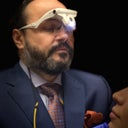Thank you for your question meldesso. I understand your concern. Botox is a purified protein used to address wrinkles associated with facial expression. When injected into the skin Botox will relax the muscles and smoothen out the overlying wrinkles. The most common areas of treatment are in the upper face. These include the horizontal lines seen on the upper forehead when one raises the brows, the vertical lines seen between the brows when one frowns (frown lines), and the crow's feet seen around the eyes when one smiles.It is difficult to make an assessment in the absence of consistent photographs before and after in the same lighting and angles for comparison. However, I hope the information provided here is useful.The muscles that are treated with Botox around the eyes are close to the muscle that lifts the upper eyelid. If this muscle is affected it can lead to a temporary droopy eyelid (blepharoptosis). The duration depends on the placement of the product and the dose used. Usually it resolves in 2 weeks, but it can last up to 4 months. Blepharoptosis can be treated with apraclonidine 0.5% ophthalmic solution (also known as iopidine) and various other medications. For my patients, I recommend 2-3 drops to the affected eye 2-3 times per day. When the blepharoptosis begins to wear off patients notice less of a droop when waking up in the morning after the last dose of apraclonidine has worn off. The incidence of blepharoptosis is reported to be approximately 1% but in my experience, I find it to be about 0.1%. This is likely due to the fact that when these studies were initially performed injectors may have not been as aware of this adverse effect nor been taking extra precautions to avoid it. Blepharoptosis occurs when Botox is placed near the eye and it diffuses to the muscle that lifts the upper eyelid (levator palpebrae superioris). This is located inside of the orbital rim above the globe. To avoid this side effect, I place the product at least 1 cm from the orbital rim. When placing product between the brows I pinch the area to be treated and lift it so that the product is placed in the muscle and is less likely to diffuse around the bone into the orbital space. Diffusion into this area may also be caused by other preventable things. For this reason, I recommend that my patients carefully follow the simple aftercare instructions described below. This may be a reason for the low incidence of side effects in my practice.With any injection, there are risks such as pain, bleeding, bruising, redness, swelling, tenderness, and infection. We take special precautions to minimize these risks such as using a painless technique. We also treat bruises with a laser as early as the next day. Bruises usually resolve within two weeks if untreated. After a laser treatment bruises usually resolve in 1-3 days, but may still take two weeks for full resolution. In addition to these risks, with Botox there is also a risk that the product spreads or diffuses to nearby structures. Spread to nearby muscles can lead to side effects such as the temporary appearance of droopy eyelids or a temporary asymmetric smile.After a Botox treatment, I recommend that my patients avoid heat exposure, alcohol consumption, and strenuous exercise for 24 hours and not lie down flat for four hours. This is because all of these activities may possibly lead to the movement of the product and consequent side effects such as droopy eyelids as described above. Although there have been no definitive studies shown that these actually occur and some physicians do not provide such aftercare instructions, in the absence of data I err on the side of caution and recommend that my patients avoid such activities.Please consult with a doctor for specific recommendations. Good luck!
